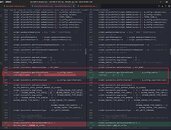- Joined
- Oct 9, 2007
- Messages
- 47,233 (7.55/day)
- Location
- Hyderabad, India
| System Name | RBMK-1000 |
|---|---|
| Processor | AMD Ryzen 7 5700G |
| Motherboard | ASUS ROG Strix B450-E Gaming |
| Cooling | DeepCool Gammax L240 V2 |
| Memory | 2x 8GB G.Skill Sniper X |
| Video Card(s) | Palit GeForce RTX 2080 SUPER GameRock |
| Storage | Western Digital Black NVMe 512GB |
| Display(s) | BenQ 1440p 60 Hz 27-inch |
| Case | Corsair Carbide 100R |
| Audio Device(s) | ASUS SupremeFX S1220A |
| Power Supply | Cooler Master MWE Gold 650W |
| Mouse | ASUS ROG Strix Impact |
| Keyboard | Gamdias Hermes E2 |
| Software | Windows 11 Pro |
The next-generation "Ada Lovelace" graphics architecture powering NVIDIA's GeForce RTX 40-series graphics cards, could see a significant increase in on-die cache memory, according to leaked source-code related to drivers or firmware, seen by XinoAssassin on Twitter. The source-code leak emanates from the recent large-scale cyber-attack on NVIDIA. When comparing source files related to Ampere and Ada architectures, XinoAssassin noticed lines that reference large cache slices.
From this, it was analyzed that the top-of-the-line AD102 silicon will have 96 MB of last-level cache on the silicon; the AD103 and AD104 chips have 64 MB; the AD106 has 48 MB, and the smallest AD107 has 32 MB. Compare this to the 6 MB on the GA102, puny 4 MB on the GA103 and GA104; 3 MB on the GA106, and 2 MB on the GA107. NVIDIA is known to make innovations in generational memory bandwidth increase and memory management, with each new architecture. The company could tap into even faster versions of GDDR6X memory it co-developed with Micron (GDDR6 with PAM4 signaling).

AMD credits its engineering choices with Infinity Cache (large on-die caches on RDNA2 GPUs) to play a key role in lubricating the memory sub-system. Since this is much cheaper than going for wider memory buses or using exotic HBM solutions; and since AMD gathered knowhow on 3D-stacked cache memory with its "Zen 3" CCDs that have 3D Vertical Caches; we expect the company to double down on Infinity Cache with RDNA3.
View at TechPowerUp Main Site | Source
From this, it was analyzed that the top-of-the-line AD102 silicon will have 96 MB of last-level cache on the silicon; the AD103 and AD104 chips have 64 MB; the AD106 has 48 MB, and the smallest AD107 has 32 MB. Compare this to the 6 MB on the GA102, puny 4 MB on the GA103 and GA104; 3 MB on the GA106, and 2 MB on the GA107. NVIDIA is known to make innovations in generational memory bandwidth increase and memory management, with each new architecture. The company could tap into even faster versions of GDDR6X memory it co-developed with Micron (GDDR6 with PAM4 signaling).

AMD credits its engineering choices with Infinity Cache (large on-die caches on RDNA2 GPUs) to play a key role in lubricating the memory sub-system. Since this is much cheaper than going for wider memory buses or using exotic HBM solutions; and since AMD gathered knowhow on 3D-stacked cache memory with its "Zen 3" CCDs that have 3D Vertical Caches; we expect the company to double down on Infinity Cache with RDNA3.
View at TechPowerUp Main Site | Source





